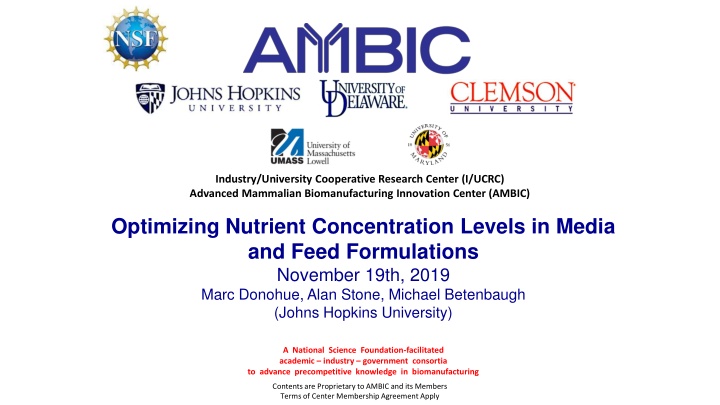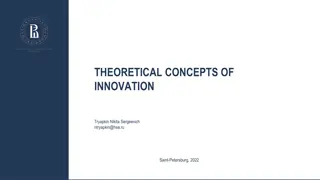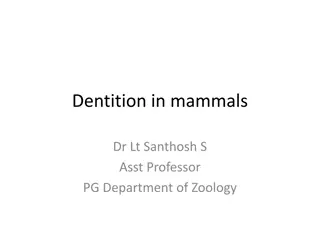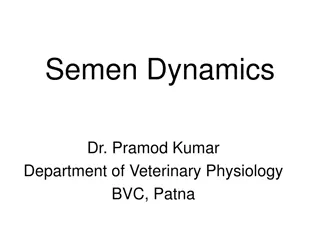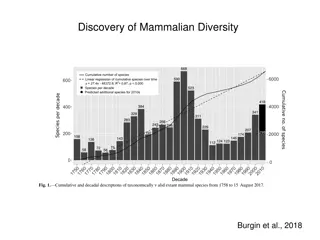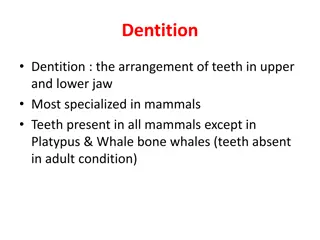Advanced Mammalian Biomanufacturing Innovation Center Overview
This content provides insights into the ongoing research and experimental updates at the Advanced Mammalian Biomanufacturing Innovation Center (AMBIC) of Johns Hopkins University. The focus is on optimizing nutrient concentration levels in media and feed formulations through experimental processes such as measuring solubility, previous results analysis, and current findings on amino acid concentrations. The center aims to advance precompetitive knowledge in biomanufacturing with the collaboration of academia, industry, and government partners.
Download Presentation

Please find below an Image/Link to download the presentation.
The content on the website is provided AS IS for your information and personal use only. It may not be sold, licensed, or shared on other websites without obtaining consent from the author.If you encounter any issues during the download, it is possible that the publisher has removed the file from their server.
You are allowed to download the files provided on this website for personal or commercial use, subject to the condition that they are used lawfully. All files are the property of their respective owners.
The content on the website is provided AS IS for your information and personal use only. It may not be sold, licensed, or shared on other websites without obtaining consent from the author.
E N D
Presentation Transcript
Industry/University Cooperative Research Center (I/UCRC) Advanced Mammalian Biomanufacturing Innovation Center (AMBIC) Optimizing Nutrient Concentration Levels in Media and Feed Formulations November 19th, 2019 Marc Donohue, Alan Stone, Michael Betenbaugh (Johns Hopkins University) A National Science Foundation-facilitated academic industry government consortia to advance precompetitive knowledge in biomanufacturing Contents are Proprietary to AMBIC and its Members Terms of Center Membership Agreement Apply
Outline Outline Experimental Updates Computational Updates GUI Distribution Updates
Experimental Updates: Measuring Solubility Experimental Updates: Measuring Solubility Limits with HPLC Limits with HPLC OPA Derivatization method: Solubility Protocol: Prepare saturated amino acid solution, leave stirring for >24h Prepare calibration standards, 8-10mM max concentration Prepare dilutions of saturated AA sample Run all calibrations / saturated samples with at least n=3 injections Histidine Chromatogram: 5mM
Experimental Updates: Previous Results Experimental Updates: Previous Results Now: Previously: Made one stock solution for calibration, measured dilutions of stock solution in triplicate This did not account for variation in preparing stock solutions Only 1 saturated amino acid sample Make 3 calibration solutions at different concentrations, measure each in triplicate This accounts for variation in stock sample solution prep Changed to measuring mass of AA and mass of H2O Make 2 saturated samples, test each at 2 temperatures (21C, 37C)
Experimental Updates: Current Results Experimental Updates: Current Results Alanine Concentration vs. Peak Area Asparagine: Concentration vs. Peak Area Serine Concentration vs. Peak Area 1800.0 1600.0 1200.0 1600.0 y = 1989.2x R = 0.9996 Peak Area (mAU*s) 1400.0 Peak Area (mAU*s) Peak Area (mAU*s) y = 1766.2x R = 0.9958 1000.0 1400.0 y = 904.77x R = 0.9939 1200.0 1200.0 800.0 1000.0 1000.0 600.0 800.0 800.0 600.0 400.0 600.0 400.0 400.0 200.0 200.0 200.0 0.0 0.0 0.0 0 0.5 1 1.5 -200.0 -0.2 0 0.2 0.4 0.6 0.8 1 -200.0 -0.2 0 0.2 0.4 0.6 0.8 1 Concentration (mg Asn / g H2O) Concentration (mg Serine/g H2O) Concentration (mg Alanine/g H2O) Solubility (g/kg) Literature Value(g/kg) Asparagine 25.3 0.2 (800X) 24.9 Data generated for His, Thr, Glu, currently processing 155 2 (800X Alanine 157.9 Serine 345 3 (1200X) 367.8
Updated Experimental Plan Updated Experimental Plan Continue measuring binary solubility for AAs Carry out ternary mixture solubility tests: 55 combinations to be tested --> ~600 samples Identify a multicompound case to confirm with model
Computational Updates Outline Computational Updates Outline Conceptual overview Accomplishments and Future Modeling challenges pH Updates and Future Work
Background: Activity and Activity Coefficient Background: Activity and Activity Coefficient Activity of a species drives flow from one phase or mixture to another, similar to electric potential or temperature dictating electron / heat flow The higher the activity = higher tendency of a substance to precipitate At equilibrium, activity of all substances in all mixtures/phases are equal The activity is concentration multiplied by some activity coefficient
Background: UNIFAC Background: UNIFAC Activity coefficient of a species depends on chemical composition of both species and the mixture UNIFAC splits a species into constituent chemical functional groups, and assumes interactions between all functional groups Functional group interactions are combined for total effect on molecule activity Net Effect: Activity coefficient goes down Solubility goes up
Background: Work Up to June Conference and Background: Work Up to June Conference and Feedback Feedback Compiled literature AA data from various sources Regressed UNIFAC interaction parameters for amino acid functional groups Developed a GUI capable of predicting solubilities of multi-compound mixtures Feedback: Enable all AA solubility predictions. This required development of experimental methods for measuring solubilities Model pH effect on amino acid dependence. This required an expansion of the model and a new modeling approach.
Background: Charged Species Background: Charged Species Charged species need to be considered for pH predictions, as well as the presence of salts in solution UNIFAC does not account for net charge / ionic interactions effects on activity coefficient Modify UNIFAC activity coefficient result by considering charged species as point charge
Background: Zwitterions Background: Zwitterions Most amino acids exist as a zwitterion at a neutral pH We assume zwitterion + neutral forms to be the same, since ratio of zwitterion to neutral amino acid is a constant ratio, and K is large.
Background: pH and Equilibria Background: pH and Equilibria pH changes cause new species to form, which are charged and thus do not precipitate according to new reaction equilibria These equilibria dictate the ratios of the amino acid present in all three forms, and thus their concentration and activity Precipitation occurs when the activity of the neutral species reaches the critical value, as only the neutral species can precipitate
Background: Complexation and Scale Background: Complexation and Scale Including pH increases complexity more than just zwitterion inclusion. In practice, pH changes driven by HCl or NaOH. Counter ions also form amino acid salts, which likely precipitate earlier than the neutral amino acid For media, other ions would also be present For each counter-ion + AA pair, have to determine equilibrium ratios, a significant increase in project scope.
Background: Multicompound and Flexibility Background: Multicompound and Flexibility For predicting solubility with multiple species in media which can undergo complexation: All the relevant equilibria (gathered in Dr. Stone s chemical complexation project) has to be accessible Based on input species, dynamically call equilibrium data, create problem to be called, and solve problem This process would have to be automated to be scalable
Computational Updates: pH predictions Computational Updates: pH predictions Modeled pH predictions are available for all binary systems Found interesting properties in Amino acids with acidic / basic side chains, causing us to model these slightly differently Implemented an in-house solver for use in Python to address convergence issues with out-of-the-box solvers Developed GUI-compatible code for neutral side-chain solubility predictions By end of year, we will have code for all 3 types of amino acids implemented in python and incorporated in the GUI
Aspartic Acid Aspartic Acid cv HAA- HAAH2(+) HAAH AA(-2) HAANa cv
Glutamic Acid Glutamic Acid HAA- HAAH2(+) HAAH AA(-2) cv
Histidine Histidine HAAH3(+2) HAAH2(+) HAAH AA(-) cv
Asparagine Asparagine
GUI Distribution Updates GUI Distribution Updates We are sending out a notice to all AMBIC company disclosing the GUI 60 days to respond, once response is received, then must negotiate a non-exclusive, royalty-free license from JHU Will be updated from current demo version.
